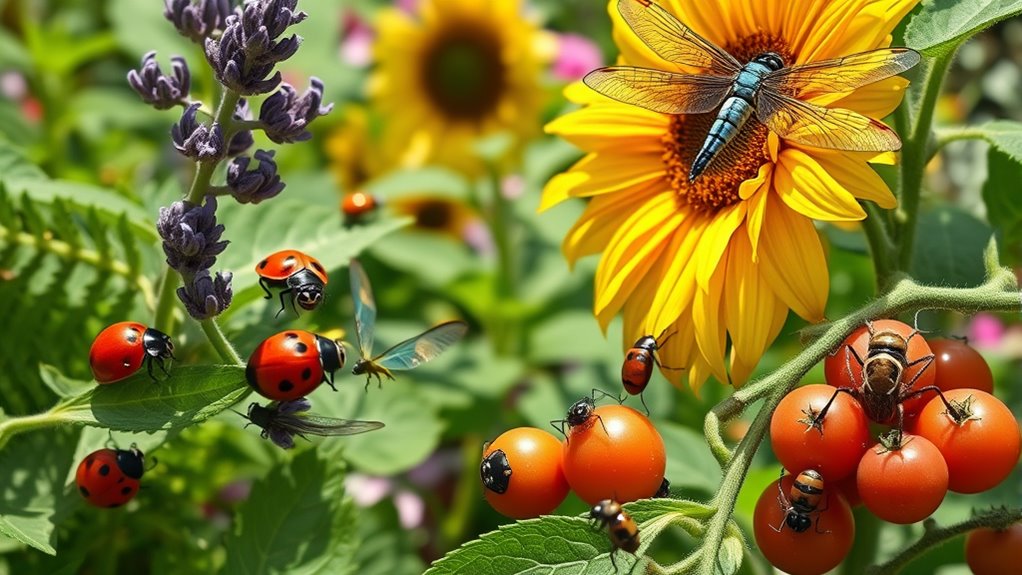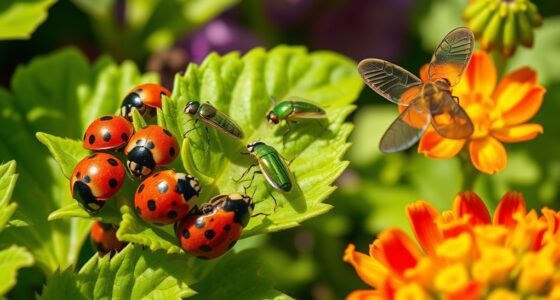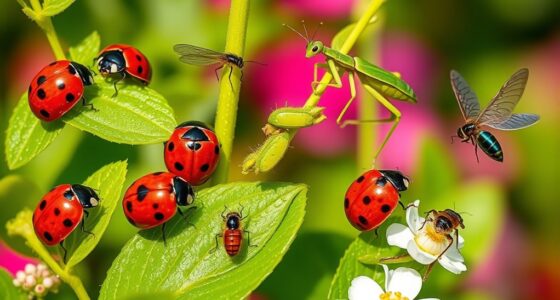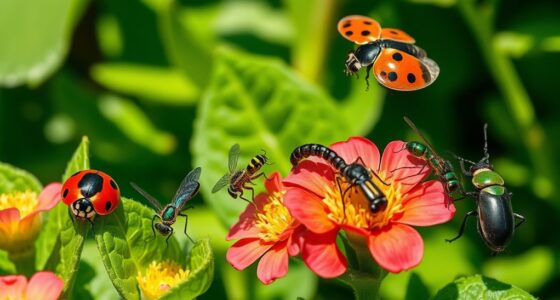Beneficial insects like ladybugs, lacewing larvae, hoverflies, bees, predatory beetles, parasitic wasps, and earthworms are essential allies in your garden. They naturally control pests like aphids, whiteflies, and caterpillars while supporting pollination for healthy plants. By creating a friendly habitat and avoiding harmful chemicals, you can attract and sustain these helpful insects. Keep exploring to discover how each of these beneficial insects can transform your gardening experience.
Key Takeaways
- Ladybugs: voracious predators of aphids, scale insects, and soft-bodied pests, essential for natural pest control.
- Lacewing larvae: known as “aphid lions,” prey on aphids, whiteflies, and caterpillars, helping reduce pest populations.
- Hoverflies (syrphid flies): larvae feed on aphids and pests; adults pollinate flowers, supporting plant health.
- Bees: vital pollinators that enhance fruit set and seed production, indirectly supporting pest management.
- Insect habitats: creating shelters like insect hotels and planting native flowers attract beneficial insects and promote a balanced garden ecosystem.

Beneficial insects are natural allies for gardeners seeking to maintain healthy, pest-free plants. These tiny helpers play a pivotal role in pest control strategies, reducing your reliance on chemical pesticides and fostering a more sustainable garden environment. By encouraging beneficial insects to thrive, you not only keep pests in check but also enhance pollination, which is essential for fruit and flower production. Understanding which insects to attract and how to support them can transform your gardening approach, making it more eco-friendly and productive.
Encourage beneficial insects to naturally control pests and boost pollination for a healthier, more sustainable garden.
Ladybugs are among the most well-known beneficial insects. They’re voracious predators of aphids, scale insects, and other soft-bodied pests that can quickly damage your plants. Introducing ladybugs or creating a habitat that attracts them can dramatically reduce pest populations. Similarly, lacewing larvae are fierce predators of aphids, whiteflies, and caterpillars. They’re often called “aphid lions” for a reason. When you foster an environment that provides shelter and food sources for these insects, you create a natural pest management system that minimizes the need for chemical interventions.
Hoverflies, or syrphid flies, are another important beneficial insect. Their larvae feed on aphids and other pests, while the adults are excellent pollinators. They contribute to pollination enhancement by visiting a wide range of flowers, helping your plants produce more fruit and flowers. To attract hoverflies, plant a diverse mix of flowers that bloom at different times and avoid using broad-spectrum insecticides that can harm them. By integrating these practices, you support a balanced ecosystem where pest control and pollination work hand-in-hand. Additionally, understanding the state regulations on pesticide use can further protect beneficial insect populations.
Bees, especially native pollinators, are essential for increasing fruit set and seed production. While not predators, bees contribute to pest control indirectly by supporting plant health and vigor. Ensuring your garden provides ample nectar and pollen sources encourages their presence. Avoiding pesticides during peak blooming times preserves their populations and keeps your garden productive.
Supporting beneficial insects isn’t just about releasing predators; it’s about creating a welcoming habitat. Use organic mulches, plant native flowers, and provide shelter such as insect hotels. Avoid chemical pesticides and herbicides, which can wipe out beneficial populations along with pests. Instead, aim for a natural balance where these insects can thrive, reducing pests and boosting pollination naturally. With a little effort, you’ll cultivate a garden that’s not only more resilient but also more vibrant and productive, thanks to the natural work of these beneficial insects.
Frequently Asked Questions
How Can I Attract Beneficial Insects to My Garden Naturally?
To attract beneficial insects naturally, start by practicing companion planting, which creates a welcoming environment for helpful bugs. Incorporate a variety of plants to increase garden diversity, providing food and shelter for these insects. Avoid chemical pesticides, as they can harm beneficial populations. By designing a diverse, pesticide-free garden, you’ll encourage beneficial insects to thrive, helping you control pests and boost your garden’s overall health effortlessly.
Are There Any Harmful Insects Mistaken for Beneficial Ones?
Beware of buzzing bugs that blend in! When practicing beneficial insect identification, you might mistake harmful insects for helpful ones. Some pests mimic beneficial insects’ colors or shapes to deceive you, making harmful insect prevention tricky. You must carefully observe their behaviors and markings to distinguish between allies and adversaries. Proper identification guarantees you protect your garden without harming beneficial insects, keeping your garden healthy, harmonious, and pest-free.
Can Beneficial Insects Harm My Edible Plants?
Beneficial insects generally don’t harm your edible plants, but you should be aware of pesticide effects that can reduce their populations. While these insects target pests, they have limitations and might occasionally feed on your crops if pest populations are low. To protect both your beneficial insects and plants, avoid broad-spectrum pesticides and encourage natural pest control methods. This helps maintain a healthy garden ecosystem without risking harm to your edible plants.
What Is the Best Time of Year to Introduce Beneficial Insects?
Timing is everything, and the right moment makes all the difference. You should introduce beneficial insects during their peak activity periods, usually in spring or early summer, when pests start to appear but before populations explode. This seasonal timing guarantees they thrive and do their job effectively. Keep an eye on local climate and pest patterns to identify the most suitable introduction period, giving your garden a natural boost right when it needs it most.
How Do I Differentiate Between Beneficial and Pest Insects?
To differentiate beneficial from pest insects, start with visual identification by noting size, color, and body shape. Observe insect behavior—beneficial insects often hover around plants, feed on pests, or pollinate flowers, while pests tend to damage leaves or stems. Keep a close eye on their movements and interactions with your plants. Recognizing these signs helps you promote beneficial insects and manage pests effectively, ensuring a healthy garden.
Conclusion
By welcoming beneficial insects like ladybugs and lacewings into your garden, you naturally curb pests and boost plant health. For example, a small organic farm in Vermont introduced ladybugs to control aphids, reducing chemical use and increasing yields. Incorporating these helpful insects creates a balanced ecosystem, making your garden more resilient and productive. So, embrace these tiny allies—your plants will thank you, and you’ll enjoy a thriving, pest-free oasis.









